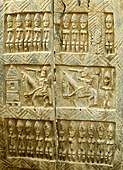Western Plains Dogon
The Dogon dialects of the western plains below the Bandiagara Escarpment is Mali are mutually intelligible. They are sometimes called the Kan Dogon because they use the word kan (also spelled kã) for varieties of speech. The dialects are:
- Tomo kã
- Teŋu kã
- Togo kã
| Western Plains Dogon | |
|---|---|
| Kan Dogon | |
| Region | Mali, Burkina Faso |
Native speakers | 260,000 (1998)[1] |
Niger–Congo
| |
| Dialects |
|
| Language codes | |
| ISO 639-3 | Either:dtm – Tomo Kandtk – Tene Kan |
| Glottolog | west2508[2] |
The latter two are traditionally subsumed under the name Tene kã (Tene Kan, Tene Tingi), but Hochstetler separates them because the three varieties are about equidistant.
There are a quarter million speakers of these dialects, about evenly split between Tomo Kan and Tene Kan, making this the most populous of the Dogon languages. There are a few Tomo-speaking villages just across the border in Burkina Faso.
Phonology
Consonants
| Labial | Alveolar | Palatal | Velar | Glottal | ||
|---|---|---|---|---|---|---|
| Stop/ Affricate |
voiceless | p | t | t͡ʃ | k | ʔ |
| voiced/nasal | b | d | d͡ʒ | g | ʔ̃ | |
| Fricative | voiceless | (ɸ) | s | h | ||
| voiced | (z) | |||||
| Nasal | m | n | ɲ | ŋ | ||
| Lateral | l | |||||
| Tap | ɾ | |||||
| Approximant | central | w | j | |||
| nasal | w̃ | (j̃) | ||||
- Consonant germination also occurs frequently among sounds [kː lː nː tː].
- /z/ can only occur among loanwords.
- /ɸ/ is interchangeable with /h/.
| Labial | Alveolar | Palatal | Velar | Glottal | ||
|---|---|---|---|---|---|---|
| Stop/ Affricate |
voiceless | p | t | (t͡ʃ) | k | (ʔ) |
| voiced | b | d | d͡ʒ | g | ||
| Fricative | (f) | s | (h) | |||
| Nasal | m | n | ɲ | ŋ | ||
| Lateral | l | |||||
| Tap | central | ɾ | ||||
| nasal | ɾ̃ | |||||
| Approximant | central | w | j | |||
| nasal | w̃ | j̃ | ||||
- Consonant sound /t͡ʃ/ only rarely occurs and in almost absent.
- Consonant sounds [z ʃ ʒ] are absent, except in loanwords.
- /ɡ/ can be realized as a fricative [ɣ] between vowel sounds /a ɔ/.
- Sounds [f h] only occur from loanwords, and are interchangeable.
- Glottal sound [ʔ] can only occur as an element in some reduplicated forms of vowel-initial words, or between vowels within a word.
Vowels
| Oral | Nasal | |||
|---|---|---|---|---|
| Front | Back | Front | Back | |
| Close | i iː | u uː | ĩ ĩː | ũ ũː |
| Close-mid | e eː | o oː | ẽ ẽː | õ õː |
| Open-mid | ɛ ɛː | ɔ ɔː | ɛ̃ ɛ̃ː | ɔ̃ ɔ̃ː |
| Open | a aː | ã ãː | ||
- In Tomo Kan, an extra central vowel sound [ʉ] is also attested possibly as a result of /i/ preceding a nasalised segment or a /u/. It may also regularly be pronounced as [u] as well.[3]
gollark: I don't see why not.
gollark: In many fields people manage to think about and consider problems they do not directly experience.
gollark: Someone can tell you about them.
gollark: It may, perhaps, be more productive to explain things rather than saying "you literally cannot understand".
gollark: ...
References
- Tomo Kan at Ethnologue (18th ed., 2015)
Tene Kan at Ethnologue (18th ed., 2015) - Hammarström, Harald; Forkel, Robert; Haspelmath, Martin, eds. (2017). "Western Plains Dogon". Glottolog 3.0. Jena, Germany: Max Planck Institute for the Science of Human History.
- Dyachkov, Vadim (2019). A Grammar of Tomo Kan Dogon.
- Heath, Jeffrey (2015). A Grammar of Togo Kan. University of Michigan.
- Blench, Roger (2005). "A survey of Dogon languages in Mali: Overview". OGMIOS: Newsletter of Foundation for Endangered Languages. 3.02 (26): 14–15. Retrieved 2011-06-30..
- Hochstetler, J. Lee; Durieux, J.A.; E.I.K. Durieux-Boon (2004). Sociolinguistic Survey of the Dogon Language Area (PDF). SIL International. Retrieved 2011-06-30.
This article is issued from Wikipedia. The text is licensed under Creative Commons - Attribution - Sharealike. Additional terms may apply for the media files.
